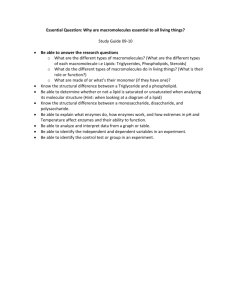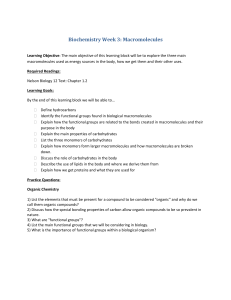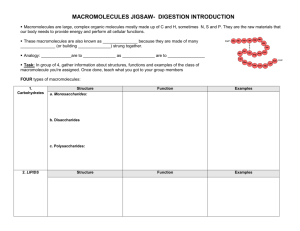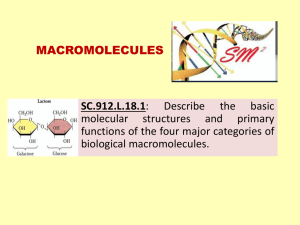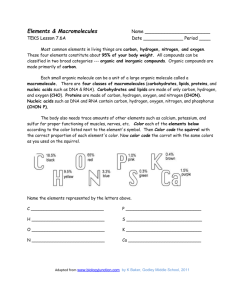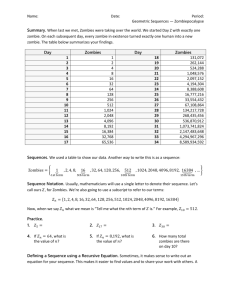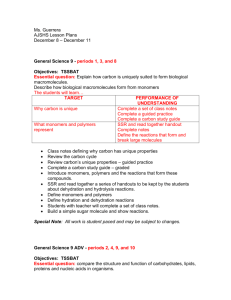The BIG Four - Macromolecules Lab Answer Key 1. What are the
advertisement
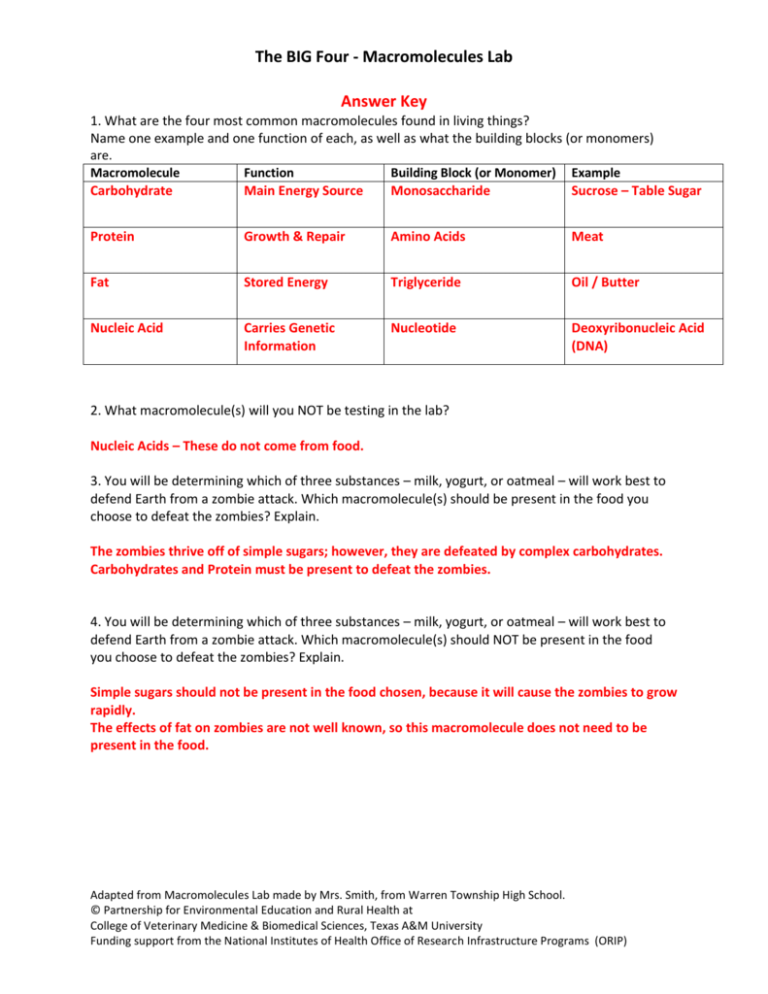
The BIG Four - Macromolecules Lab Answer Key 1. What are the four most common macromolecules found in living things? Name one example and one function of each, as well as what the building blocks (or monomers) are. Macromolecule Function Building Block (or Monomer) Example Carbohydrate Main Energy Source Monosaccharide Sucrose – Table Sugar Protein Growth & Repair Amino Acids Meat Fat Stored Energy Triglyceride Oil / Butter Nucleic Acid Carries Genetic Information Nucleotide Deoxyribonucleic Acid (DNA) 2. What macromolecule(s) will you NOT be testing in the lab? Nucleic Acids – These do not come from food. 3. You will be determining which of three substances – milk, yogurt, or oatmeal – will work best to defend Earth from a zombie attack. Which macromolecule(s) should be present in the food you choose to defeat the zombies? Explain. The zombies thrive off of simple sugars; however, they are defeated by complex carbohydrates. Carbohydrates and Protein must be present to defeat the zombies. 4. You will be determining which of three substances – milk, yogurt, or oatmeal – will work best to defend Earth from a zombie attack. Which macromolecule(s) should NOT be present in the food you choose to defeat the zombies? Explain. Simple sugars should not be present in the food chosen, because it will cause the zombies to grow rapidly. The effects of fat on zombies are not well known, so this macromolecule does not need to be present in the food. Adapted from Macromolecules Lab made by Mrs. Smith, from Warren Township High School. © Partnership for Environmental Education and Rural Health at College of Veterinary Medicine & Biomedical Sciences, Texas A&M University Funding support from the National Institutes of Health Office of Research Infrastructure Programs (ORIP) The BIG Four - Macromolecules Lab 5. Describe how you will know if a substance has lipids in it. Include pertinent indicators used. If the substance leaves a grease stain on the brown bag after the lipid test has been performed, then it has tested positive for containing lipids. 6. Describe how you will know if a substance has proteins in it. Include pertinent indicators used. The Biuret Reagent will change from blue to violet in the presence of protein. 7. Describe how you will know if a substance has simple carbohydrates in it. Include pertinent indicators used. A rusty brown color in response to Benedict’s Solution indicates a large amount of simple sugars. An orange color indicates a moderate amount of simple sugars and a green or yellow color indicates a small amount of simple sugars. A blue color indicates no simple sugars present. 8. Describe how you will know if a substance has complex carbohydrates in it. Include pertinent indicators used. Iodine causes complex carbohydrates to turn dark blue or black. Hypothesis 9. Which substance – milk, yogurt, or oatmeal – do you think will be best for defeating the zombies? Explain. This answer is variable and based on critical thinking of the student. Adapted from Macromolecules Lab made by Mrs. Smith, from Warren Township High School. © Partnership for Environmental Education and Rural Health at College of Veterinary Medicine & Biomedical Sciences, Texas A&M University Funding support from the National Institutes of Health Office of Research Infrastructure Programs (ORIP) The BIG Four - Macromolecules Lab Lab Worksheet – Answer Key Data Table Test Substance Lipid Protein Simple Carbohydrate Complex Carbohydrate X X X X X Distilled Water Cooking Oil Gelatin Solution X Apple Juice X X Potato Solution X X X Milk X X X Yogurt X X X Oatmeal X X X Analysis & Conclusions Answer the following questions using complete sentences, being thorough and including lab data when appropriate. 1. Does your data support or refute your hypothesis? Explain. The data supports the hypothesis if he/she theorized that oatmeal would be the best substance to defeat the zombies with. 2. A very thin slice is removed from a peanut and rubbed on a paper bag, leaving a stain. Then, a drop of Biuret Reagent is added to the peanut slice. When you examine the peanut slice under a microscope, patches of blue-violet are visible. What conclusions about macromolecules can you draw from your examination? The peanut butter has tested positive for the presence of protein. 3. You must save the world! Using your data and the information provided by the scientists (in the introduction), which of the substances – milk, yogurt, oatmeal – is the best defense against the zombies? Explain ALL pertinent reasons. Oatmeal would be the best choice to defeat the zombies with because it tested positive for complex carbohydrates and protein. While yogurt and milk also tested positive for protein, they tested positive for simple carbohydrates. These simple carbohydrates would cause the zombies to thrive and grow, making these substances unsuitable for defense. Adapted from Macromolecules Lab made by Mrs. Smith, from Warren Township High School. © Partnership for Environmental Education and Rural Health at College of Veterinary Medicine & Biomedical Sciences, Texas A&M University Funding support from the National Institutes of Health Office of Research Infrastructure Programs (ORIP)

